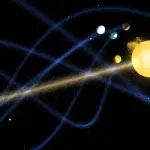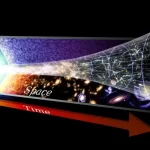Key Takeaways:
- Black holes, enigmatic cosmic phenomena, challenge conventional understanding by distorting space and time to the point where even light cannot escape.
- Recent scientific papers propose a reevaluation of black hole theory, suggesting that they may not endure indefinitely and questioning our understanding of their central characteristics.
- Singularities, theoretical points of infinite density at the heart of black holes, prompt the need for alternative mathematical frameworks such as quantum gravity.
- Loop quantum gravity, a theoretical model describing space-time as a network of evolving loops, offers insights into the nature of black hole interiors, potentially replacing singularities with regions resembling white holes.
- Experimental validation remains crucial to substantiate theoretical propositions, with ongoing observations of high-energy cosmic phenomena serving as potential indicators of black hole transitions to white holes.
Black holes stand as enigmatic entities within the vast expanse of the cosmos. These celestial phenomena represent regions where the very essence of space and time undergoes severe distortion, rendering them impassable even to the swiftest of entities, light itself. In accordance with Einstein’s theory of general relativity, these enigmatic entities harbor singularities at their core, points where the collective mass of numerous stars collapses into infinitesimal volumes. However, recent scientific literature challenges established notions regarding the perpetual existence of black holes and suggests a fundamental misunderstanding concerning their intrinsic nature, particularly regarding their central characteristics.
The Conundrum of Singularities
Astronomers and physicists have long grappled with the notion of singularities inherent to black holes, deeming them potentially fallacious. The concept of an entity possessing mass yet lacking volume, and consequently exhibiting infinite density, contradicts the principles of natural existence. Such infinities, while commonplace in theoretical discourse, find no tangible manifestation within the fabric of reality. Instead, they serve as indicators of the limitations of current mathematical frameworks, heralding the necessity for novel mathematical paradigms.
A familiar illustration of this concept can be found in Newton’s law of gravity, which posits that gravitational attraction varies inversely with the square of the distance between two objects. As an object approaches the Earth’s surface, according to this law, gravitational force theoretically approaches infinity. However, empirical observation reveals a deviation from this prediction, necessitating the incorporation of more intricate models to accurately depict gravitational interactions. Similarly, while Einstein’s general relativity predicts the existence of singularities within black holes, the validity of such predictions diminishes at infinitesimal scales, prompting the consideration of alternative theories such as quantum gravity.
Quantum Gravity
Quantum gravity, as a theoretical construct, signifies the amalgamation of gravitational principles with quantum mechanics at microscopic scales. While the term encompasses a broad spectrum of theoretical frameworks, one prominent proposal is loop quantum gravity.
Loop quantum gravity represents a mathematically rigorous formulation portraying space-time as a network of interconnected loops evolving dynamically. These loops, known as spin networks, provide a mathematical description of particle-field interactions. Moreover, loop quantum gravity postulates the quantization of space-time, implying the existence of a fundamental unit beyond which further subdivision becomes untenable.
Application to Black Hole Interiors
Despite the formidable mathematical complexity inherent to loop quantum gravity, recent efforts by researchers such as Abhay Ashtekar, Javier Olmedo, and Parampreet Singh have endeavored to extend its applicability to the interiors of black holes. Contrary to conventional notions of singularities, their calculations suggest a curvature of space-time so profound that it precludes singularity formation. Instead, the resultant space-time continuum exhibits characteristics akin to those of a white hole, a hypothetical entity inversely analogous to a black hole, expelling matter rather than engulfing it.
A Shift in Perspective
One plausible interpretation of these findings posits a cyclical process wherein matter undergoes gravitational collapse within black holes before experiencing a rebound effect, propelling it outward into the cosmos. Given the temporal dilatation near black hole cores, this process unfolds over immense time spans, potentially spanning epochs. However, it is imperative to exercise caution in embracing these conjectures, as theoretical concepts must withstand empirical scrutiny before attaining scientific validation.
Towards Experimental Validation
Efforts to substantiate these theoretical postulations through empirical observation remain ongoing. High-energy astronomical phenomena, such as cosmic rays and fast radio bursts, present intriguing avenues for probing the transition from black holes to white holes. Continued refinement of calculations employing loop quantum gravity holds the promise of elucidating hitherto unexplained cosmic phenomena, thereby refining our understanding of the universe’s past and future trajectories.
In conclusion, while the conjecture of black holes evolving into white holes presents a tantalizing prospect, its validation hinges upon rigorous empirical investigation and theoretical refinement. Only through concerted interdisciplinary efforts can we hope to unravel the mysteries shrouding these enigmatic cosmic entities and unveil the true nature of the universe’s temporal tapestry.


